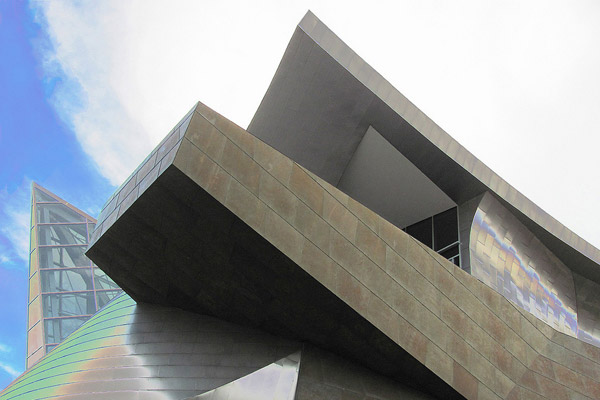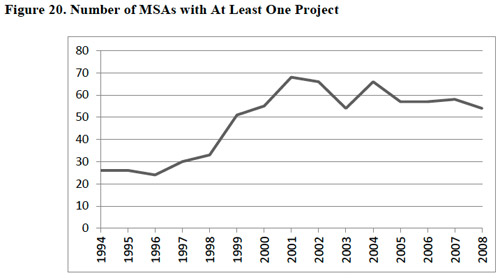
My hometown made a rare appearance in the New York Times, at least for something other than how a $1,200 payment to a sustainability nonprofit was the leading edge of the UN-planned Agenda 21 takeover of Roanoke, the Southwestern Virginia city of 94,000 being the sort of subtle target you would expect from the devious mind of Nicolae Carpathia. This time, it was for actual good news in urbanism: downtown renewal led by 44-year-old developer Ed Walker, "a former outsider-art dealer and a third-generation lawyer from a prominent local family," all of which is extremely Southern. He's trying to bring to the city the sort of small-scale art businesses it never had when I was growing up there:
The Kirk Avenue Music Hall, a four-year-old club named for its downtown block here, offers an unexpected perk to its performers: an apartment. For a night or so, before or after gracing the stage, artists stay at no charge in a loft a block away, signing the guest book with notes of gratitude.
[snip]
The building also houses the Music Place, an FM radio station that Mr. Walker bought last year just before it was forced to change formats. With its mix of indie, country and folk — and thrice-weekly interviews with community leaders — it fit with his notion to give Roanoke the feel of, as he grinningly puts it, a funky college town.
Roanoke actually has two four-year colleges (well, one of them is in Salem, the Evanston of Roanoke). Neither are particularly funky. The city's had trouble retaining natives who are into that sort of thing… people like me, actually. In the article, Roanoke is compared unfavorably to Asheville, that being the gold standard of hip small southern cities. But Asheville has two colleges that, between them, make a good blend, a big public school in UNC-Asheville and a small, defiantly independent one in Warren Wilson, plus decades of counterculture history. Roanoke's most famous artistic legacy is Wayne Newton, and perhaps the early Chicago filmmaker Oscar Michaeux's time there. Roanoke is trying to create such an atmosphere from scratch.
Cities throughout the South and the Sun Belt are trying to build the foundation for an urban renaissance. As I found while researching a piece for GOOD, some of this development is focused on smaller venues, like Omaha's partnership on Slowdown with Saddle Creek Records. It's in marked contrast to the findings of a recent University of Chicago study, "Set In Stone," on the nationwide building boom in museums, theaters, and performing-arts centers.
During the bubble economy of the late 1990s, there was a leap in the contruction of these three types of cultural infrastructure:

Locally, as Chris Jones notes, that got us the Harris Theater for Music and Dance and the Art Institute's Modern Wing. But the majority of that spending was in the South:
The Southern region of the U.S. experienced a higher level of building than all other regions between 1999 and 2003, and between 2004 and 2008. Between 1999 and 2003, the Southern region invested an average of approximately $519 million into cultural building as compared to $348 million, $316 million, and $278 million in the Midwestern, Western, and Northeastern regions, respectively. Between 2004 and 2008, the Southern region invested approximately $367 million, while the Western, Midwestern, and Northeastern regions invested approximately $266 million, $243 million, and $197 million, respectively.
In 1990, the South had the lowest number of cultural facilities per 100,000 of any region in the country (less than half that of the West or Northeast), and between 1990 and 2000 the South led all regions in the growth of the percent of population with a bachelor's degree. To follow the money and lock in those gains, the South built a lot of cultural facilities, at great cost. And the big cautionary tale is Roanoke. In 2007, the $66 million Art Museum of Western Virginia, aka the Taubman, designed by Frank Gehry protege Randall Stout, opened in the city's downtown. The purpose was to turn Roanoke into the next Bilbao, and estimated project costs ballooned from $7-$15 million in 1999 to several times that by the time it opened.
The result has been something of a boondoggle:
The museum has been using incoming donations originally earmarked for paying back those donor loans to patch its annual revenue hole. The individuals and foundations who helped the Taubman pay off the building have agreed to the arrangement, Executive Director David Mickenberg said. Yet he knows it's not a viable long-term solution.
[snip]
Still, there have been bright spots. The membership drive kicked off in November 2010 has since brought the museum more than 3,200 members — still short of the ultimate goal of 6,000 to 7,000 but better than the 2,848 reported that November.
Also, thanks to its corporate-sponsored free Saturdays, which began in May, attendance has jumped from an average of 150 on Saturdays to between 600 and 1,100.
In 2007, the museum estimated 500 visitors a day would be needed to cover costs. Before the gates were opened up to everyone, it was getting less than a third of that on its most important day of the week.
The "Set In Stone" report has been taken as evidence that the U.S. built too many cultural centers by writers at ArchDaily and The Atlantic Cities:
That being said, it's becoming pretty clear that during the boom years, American cities built too many of them, surpassing demand with a supply that would come to weigh down arts institutions that had no business chasing after their own Guggenheim Bilbao. A massive new study by the Cultural Policy Center at the University of Chicago reaches this conclusion after surveying 725 new arts facilities and expansions that sprang up in American cities between 1994 and 2008, at a collective cost of more than $15 billion.
But that's not how I read the study, and the Taubman is a good example. Before the Taubman moved into its new building, it had 8,000 square feet of gallery space. The plan for the new building was to have 66,000 square feet, 20,000 of which would be devoted to galleries. The actual building turned out to be much larger: 81,000 square feet. The gallery space? 15,000 square feet. The cost went up; the building grew; the actual space devoted to the main purpose of the museum shrunk.
Compare that to the actual Guggenheim Bilbao: opened a decade before for $89 million, or about $115 million in 2007 dollars, the Bilbao opened with 257,000 square feet, 112,000 of which was devoted to galleries. That's 40 percent devoted to gallery space. Less than 20 percent of the Taubman is gallery space, in part because no art can be put on the first floor—it's in a flood plain, so no one will insure it. I went to the Taubman on my last trip to Roanoke. Some of the art is excellent (like Antoinette Hale's The Debutante) and it's had some forward-looking exhibitions (like Chicagoan Nick Cave's soundsuits) but we were done in about an hour. The price was then $10.50, $1.50 less than the MCA, though it's been dropped to $7. It just wasn't big enough to suggest a repeat visit anytime soon, so the paucity of visitors hasn't come as a surprise.
Like the other case studies in "Set In Stone," the Taubman was extremely overplanned, and is now underfunded; it has fewer employees than it did in its old space. The Art Institute itself had to institute layoffs and cutbacks after the creation of its more successful Modern Wing, but it's a huge, old institution, and itself is not at risk. The lesson of "Set In Stone" seems to be less that we overbuilt in the sense of too many, but in the sense of too large. I'm hoping Ed Walker's plan for the kind of small, self-sustaining amenities that make a city great—Roanoke's Hideout, or Empty Bottle—are more successful.
Photograph: o palsson (CC by 2.0)



